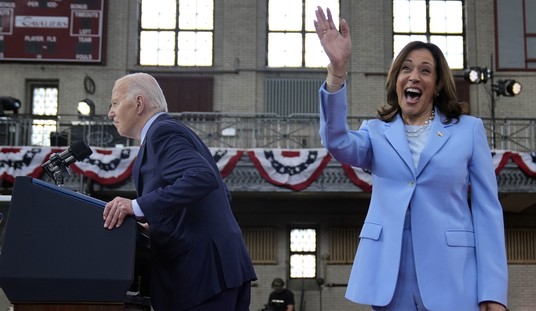Day of Infamy
Sixty-five years ago today we were attacked at Pearl Harbor. I wrote today in my weekly Tribune Media Services column , why, unlike our forefathers, we haven’t been able to finish the war within four years following that similar preemptory and surprise attack on American soil.
Suffice to say that when the Democrats allege incompetence because we are not yet victorious, they forget we have lost 50 soldiers a month since September 11, not 8,000 as was true of every month during World War II. And it is much easier to carpet bomb Tokyo, as horrendously difficult as that was, than to go into Fallujah and sort out the terrorists from the “innocent” under the glare of a hostile globalized media, and a disunited American public, some of whom believe that Cindy Sheehan or Michael Moore should be consulted for their superior wisdom.
Mistakes and then there were mistakes
I haven’t engaged much in the parlor game of identifying mistakes in the occupation, because none of them (and there were many) reached a magnitude of those in World War II (e.g., daylight bombing without fighter escort in 1942-3, intelligence failures about the hedgerows, surprise at the Bulge, etc) or Korea (surprise at the Yalu). Nor were any fatal to our cause, despite the ‘disbanding’ of the army, Abu Ghraib, etc. If there were any serious blunders, they concerned the sense of hesitation that gave our enemies confidence—the sudden departure of Gen. Franks, the pullback from first Fallujah, the reprieve given Sadr, etc. In other words, once we were in a war, whatever public downside there was to using too much force was far outweighed by losing our sense of control and power, and ceding momentum to the terrorists. So we can learn from that, and begin again cracking down hard on the insurgents before calling for more troops.
A Bad Spell
We, deliberately or inadvertently, have empowered our enemies this last month or so by the Rumsfeld departure, the grandstanding comments about failure in the Gates confirmation hearing, the Bolton resignation, and now the Iraq Study Group, all of which conspired to convey the image of an overripe, juicy American plum easy to be picked off by assorted enemies. Which brings us back to …
The Baker Commission…
I just finished reading the 107 page PDF version of the Iraqi Study Group report, and posted something on National Review about initial reactions. There is the obviously accurate diagnosis of the problem that a weak elected government in Iraq has been able neither to provide enough basic services to the people to ensure their support, nor to marshal the will to kill the jihadists—given various Shiite and Sunni militias’ infection of the government itself.
Some of their suggestions are likewise clearly sober, such as more training of Iraqi troops and the blunt threat to the Iraqi government to rein in the militias since the American commitment is not open-ended. But while accurately describing symptoms and forming a diagnosis, most of its other recommended therapy and prognosis are surreal.
Does anyone really believe that Syria and Iran, at least in the short-term, abhor chaos in Iraq? Iran fought a long war with Iraq, and fears deeply American scrutiny of its nuclear program. Only a perceived mess in Iraq keeps the attention of the United States and, indeed, the world community away from Teheran. Ditto Syria that does not want more Cedar Revolutions on its borders, given that democracies or the efforts at such in Iraq, Israel, Lebanon, and Turkey now surround this dictatorship.
There were three wars fought to destroy Israel before the Golan Heights were taken. The withdrawal from Lebanon and Gaza did not lead to commensurate moderation on the part of the Islamists or dictators. And if the Study Group believes that Israeli concessions will result in Syria and Iran “helping” us in Iraq, they are wrong on both counts. The most these two terrorist regimes will do is offer a safe “escort” out before the deluge; and, second, we will have reestablished the old principle that the way for radical Islamic and Arab regimes to pressure Israel is through attacking American interests in the Middle East.
The Syrian Enigma
Finally, why are there not terrorists attacks originating from Syria on the Golan Heights? That is, why don’t the Syrians send in various teams to broach the borders and ascend into Israel, or at least shell or send missiles against Israeli positions? Why not at least one Kassem or Katyusha targeting an Israeli outpost or winery in the Golan? The answer probably is deterrence; that is, Syria knows that a single Israel plane might in response take out the power grid of Damascus for a year or so.
So the Assad regime use surrogates in Lebanon or the West Bank that offer deniability of culpability of sorts. After all, hit back at the West Bank and you only add to the “misery” of the poor “refugees” and end up on CNN. The same is true of Lebanon.
But Damascus? That is a horse of a different color. The regime is hated; its infrastructure is vulnerable to conventional attack; and a few GPS strikes in the middle of the night to hit an airfield or power station would be finished by the time of CNN’s or Al Jazeera’s morning news.
So Syria understands that it can be harmed, without much publicized collateral damage, and to the silent satisfaction of the most of the Middle East. And as a result, Damascus does not actively wish to be seen mounting terrorist attacks—and why there is such hesitance should be a lesson for everyone involved. After all, even the French do not advocate talking with the Syrians.
Our Military
It seems banal to suggest that we need to change “tactics” in Iraq, not either withdraw or pour in more troops. But I think that is still the correct approach. We forget that the jihadist websites are still worried about Iraq, both the losses suffered there, and the emergence of a democratic government. We think we are not winning, but so do they think they aren’t either.
Without new rules of engagement and a radical shake-up in operations, 30-40,000 more American troops, circa the pattern in Vietnam around 1965, will only increase the rear echelon compounds and offer more targets, while assuring Iraqi dependency. Instead, we should aim for the situation in Vietnam around 1973-4 where we had withdrawn ground troops, but not air support and material aid.
But FIRST to get to that point the United States military is going to have to offer a broader window of opportunity for the political solution by defeating the jihadists and killers. I am all for more troops—but only if the parameters of action are commensurately enlarged as well and then, and only then, we are sure that we presently don’t have sufficient manpower to conduct air strikes on the borders to stop infiltration or enough embedded American troops within Iraqi units.
In the meantime we can change our ratios of deployment: less soldiers in enormous compounds to the rear, and the green light to target militias heads like Moqtadar Sadr, preferably with mixed American and Iraqi units.
Otherwise pouring in more manpower will only exacerbate the situation. Right now with all coalition troops and Iraqi security forces combined, we must be nearing 450,000-500,000 soldiers pitted against perhaps 10,000 terrorists. Thus the problem is not numbers per se, but the conditions of engagement under which the enemy finds advantage regardless of numerical inferiority.
California Dreaming–Again
I have developed a sort of ritual recently of driving from the High Sierra (Huntington Lake, ca. 7,200 feet), descending into the San Joaquin Valley and stopping at the farm for work and maintenance (southwest of Selma, between Fresno and Visalia), and then continuing over to sea-level at the Hoover on the Stanford Campus.
Trying to be empirical rather than romantic, one nevertheless must admit that this state offers one of the most rare landscapes in the world. Anyone can leave a vast untouched Sierra alpine forest, snowbound, and on the edge of an even more vast wildness to the immediate east over Kaiser Pass, and then within one-and-a half hours descend through foothills into the richest agricultural land in the world—still at this late date not yet completely turned into a San Jose or San Fernando Valley, and replete with orange groves, table-grape vineyards, and endless miles of tree-fruit. Then in a little less than three hours, you drive over a Mediterranean-like coast range and end up near the Pacific with a climate like the Greek or Italian seaside.
We sometimes rightly cry about despoiling our natural heritage. But eastward 50 miles from the Stanford campus to the coast are literally millions of acres that are untouched, and relatively unknown—as is true even in the corridor surrounding the 280 freeway. And this radical change in landscape within hours is matched by equally radical cultural transmogrification as well.
Up in the Sierra at this time of year, there are a number of rugged, 1940s types who plow snow, supply propane, or work for the power company who are as eccentric as admirable in their contrariness and independence.
The world should visit the Valley below to see how various races and religions live in relative harmony without killing each other. Millions of Mexicans, whites, blacks, Punjabis, Southeast Asians, Armenians, and Filipinos intermarry, integrate, and assimilate. Tuesday in Fresno County in the space of 30 minutes I drove by a Catholic Church, Greek Orthodox Church, mosque, Sikh temple, and synagogue—and about thirty Protestant congregations from Unitarian to Church of the Holy Redeemer. Anywhere else in the world—the Parisian suburbs, Darfur, the Balkans, Iraq, Afghanistan, the Congo, etc., such races and religions would be letting off bombs, assassinating or rioting.
And yet, and yet somehow the United States is pilloried for its “anti-Muslim” stance. When one reads that the Chinese government does not even allow the electric amplification of mosque prayers, that Moscow flattened Grozny to global silence, that the Arabs grow quiet when a Hama is leveled or the Kurds gassed, or that Africa is a story of serial genocide, and instead we are still talking of Guantanamo, then reason fails and we enter the dark world of primordial emotions, as hearts and minds are governed by envy, honor, jealousy, and a sense of inferiority.
But moving on: the most notable cultural achievement of the Valley is a shared allegiance to hard work, family tradition, and the sense of the land that combines to destroy pretension and self-importance. Valley people cannot stand affectation; and are great haters of all pretense.
Finally, under three hours away, then comes the sociology of the Bay Area . . .
But while it would be easy to caricature the pampered, selfish nature of many of these overachievers in Silicon Valley, and the manifestations of their newfound wealth—lavish homes, BMWs, electronic gadgetry—there is also an undeniable talent and egalitarian competitiveness, a meritocracy at work that creates new things of value to the world and, especially, to the United States. And all that energy and brilliance are sometimes apparent on the street of a Palo Alto or Menlo Park—something to grant and appreciate, albeit in small doses of a day or so. It is a world away from the Sierra or Selma, but in a strange way a logical part of this most unusual state.
Well, that was a long excursus about the eerie geographical and cultural miscellany of a great state—beautiful and majestic even at its supposed eleventh hour.








Join the conversation as a VIP Member